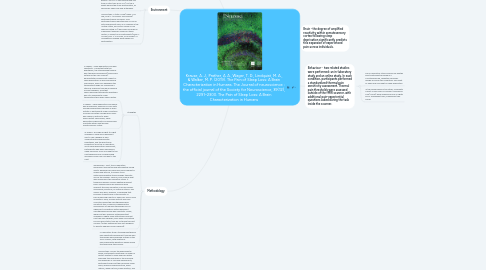Krause, A. J., Prather, A. A., Wager, T. D., Lindquist, M. A., & Walker, M. P. (2019). The Pain of Sleep Loss: A Brain Characterization in Humans. The Journal of neuroscience : the official journal of the Society for Neuroscience, 39(12), 2291–2300. The Pain of Sleep Loss: A Brain Characterization in Humans
by Csilla Talamasz

1. Cognition
1.1. sleep and pain connection
1.2. sleep loss/sleep deprivation
1.3. experience pain
2. Environment
2.1. Laboratory study: Twenty-five healthy adults, age 18–30 years (mean ± SD: 20.8 ± 1.95 years, 48% female) completed a repeated-measures crossover design (described above). Participants abstained from caffeine and alcohol for the 72 h before and during the entire course of the study and kept a normal sleep–wake rhythm (7–9 h of sleep per night with sleep onset before 1:00 A.M. in the morning and rise time no later than 9:00 A.M.) for the 3 nights before the study participation, as verified by sleep logs and actigraphy.
2.2. Online study: A total of 236 (mean ± SD age, 36.61 ± 10.8 years; 50% female) participants were surveyed. Only participants who reported pain on one or both assessment days, an IP address in the United States, and a prior online MTurk approval rating of ≥95% were included in subsequent analyses. Based on these factors, a subset of 60 participants (mean ± SD age, 38.4 ± 10.4 years, 42% female) of candidates surveyed were eligible for participation.
3. Methodology
3.1. Strengths
3.1.1. In regard - Sleep deprivation and pain sensitivity : Consistent with the hypothesis, the standardized thermal pain threshold assessment (performed outside of the MRI scanner) demonstrated a significant impact of sleep deprivation on pain processing. Specifically, sleep loss expanded the temperature range for classifying a stimulus as painful through a lowering of pain threshold, such that sleep-deprived participants registered pain at a significantly lower temperature than when sleep-rested.
3.1.2. In regard - Sleep deprivation and neural pain processing: Analyses of fMRI data revealed bidirectional changes in brain activity in participants under conditions of sleep loss within recognized a priori pain regions, relative to when sleep-rested. Specifically, sleep deprivation significantly increased pain reactivity within right primary somatosensory cortex.
3.1.3. In regard - Ecological night-to-night changes in sleep and subsequent day-to-day changes in pain: Supporting the experimental hypothesis, and the directional predictions from the in-laboratory acute sleep deprivation experiment, participants who had a decrease in sleep efficiency from one night to the next experienced a corresponding increase in pain from one day to the next.
3.2. Weaknesses - First, the in-laboratory experiment was performed with healthy young adults. Because pain becomes more frequent in middle and late life, it remains to be determined whether these findings translate across the lifespan. Second, only noxious heat was examined in the laboratory study. It therefore remains unclear whether different brain changes would be observed using different stimulus modalities, such as noxious mechanical, electrical, or chemical stimuli. This seems less likely, however, considering that previous studies show a commonality of pain-enhancing effects of sleep loss across such modalities. Third, as brain activity was only collected during the suprathreshold pain sensitivity task, inferences regarding the mechanisms of reduced thresholds rely on significant correlations with subsequent suprathreshold neural pain reactivity. Finally, while post hoc analyses established that changes in nightly sleep statistically forecast next-day pain changes, even when accounting for prior pain status, they do not prove this fact causally (as this experiment was not designed to directly address causal ordering).
3.3. In-laboratory study: standardized thermal pain sensitivity assessment: thermal pain thresholds were assessed outside of the fMRI scanner, with additional pain-experiential questions asked during the task inside the scanner.
3.4. Online study: Across the experimental phase, participants quantified a number of factors related to sleep and pain within specified time windows of the mornings and evenings. In morning assessments, participants filled out the Karolinska Sleep Diary, which included bed time, sleep latency, wake-up time, sleep duration, and subjective sleep quality on a 5 point scale Sleep efficiency was calculated from these daily diaries, based on percentage of time asleep out of total sleep duration (i.e., total sleep time minus sleep latency and total wake time after sleep onset). To characterize changes in affect, participants reported current mood and anxiety, using the Positive and Negative Affective Scale and State-Trait Anxiety Inventory questionnaires, respectively. To assess the influence of nightly sleep on subsequent next-day pain, participants quantified their physical pain experience that day (input between 6:00 P.M., day's end) and rated the average magnitude of that pain on a 100 point scale (0 representing No Pain and 100 representing Worst Pain Imaginable).
4. Brain - the degree of amplified reactivity within somatosensory cortex following sleep deprivation significantly predicts this expansion of experienced pain across individuals.
5. Behaviour - two related studies were performed: an in-laboratory study and an online study. In each condition, participants performed a standardized thermal pain sensitivity assessment. Thermal pain thresholds were assessed outside of the fMRI scanner, with additional pain-experiential questions asked during the task inside the scanner.
5.1. The in-laboratory study involved 25 healthy adult participants enrolled in a counterbalanced, repeated-measures design involving two conditions: one night of sleep and one night of sleep deprivation
5.2. In the online phase of the study, a separate cohort of 236 users of Amazon Mechanical Turk (MTurk) were assessed across 2 nights and 2 subsequent days, sleeping as they chose.

